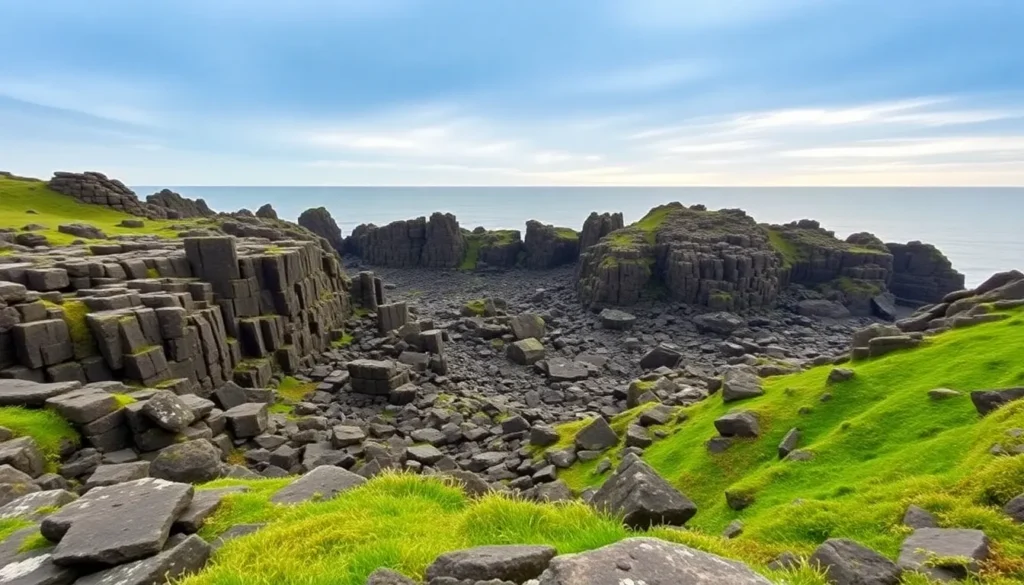Guide to Visiting the Giant's Causeway: Tips and Experience

In the windy coast of Northern Ireland, where the roar of the sea meets the whispers of the wind, lies the Giant's Causeway, a truly magical location that captivates all who venture there. With its thousands of striking black basalt columns, it draws the attention of travelers exploring Ireland. If you are planning to be one of them soon and are wondering how to visit the Giant's Causeway, pay close attention, as we’ll provide you with the best tips, essential information, and share our unforgettable experience visiting this unique spot.
Giant's Causeway: everything you need to know
Every stone at the Giant's Causeway hides a story, and with over 40,000 basalt columns formed 50 million years ago, imagine the tales these stones could tell. Here, you can observe, touch, and feel those hexagonal structures that seem to rise from the very depths of the Atlantic Ocean.
This corner of Northern Ireland is more than just a site; it serves as a portal to the past, reflecting a time when volcanic fury shaped this landscape like the work of the greatest artist. The natural beauty and geological significance of the Giant's Causeway led to its designation as a UNESCO World Heritage Site in 1986, making it one of the must-see attractions in Ireland.
Let’s delve into all you need to know about the Giant's Causeway and how to explore it:
1. How the Giant's Causeway was formed
It all began around 50 million years ago, during a time of significant volcanic activity in this northern region of the island. When lava from deep within the Earth reached the frigid waters of the Atlantic Ocean, it solidified almost instantly, transforming into basalt. This rock cools in a unique manner, forming six-sided patterns known as hexagons.
The spectacle is further enhanced by how the thousands of basalt columns at the Giant's Causeway fit together seamlessly, resembling a giant puzzle crafted by nature. As you walk upon them, you’ll marvel at the perfection of their sides and how they overlap to create this intricate formation known as the "Giant's Causeway," a name steeped in legend...
2. Mythology surrounding the Giant's Causeway
In Ireland, stories and legends are cherished as much as a pint of beer, and naturally, a tale accompanies the creation of the Giant's Causeway...
According to legend, a giant Irishman named Finn McCool lived in these remote coastal regions. One day, while gazing at the horizon, he noticed a colossal figure on the distant shore of Scotland—another giant, Benandonner, whose size overshadowed any mountain in the vicinity.
This sight sparked a rivalry between them, with both giants claiming to be the bravest and most powerful. Benandonner challenged Finn to a duel, which led to the intervention of Oonagh, Finn's clever wife. Fearing Finn would be outmatched, she dressed him as a baby and placed him in a cradle-shaped rock. When Benandonner arrived and saw the “baby,” he was struck with terror; if the child was this enormous, he could only imagine the size of the father, prompting him to flee in fright, destroying the pathway behind him to prevent pursuit.
And thus, the Giant's Causeway was born!
3. How to get there, costs, and parking at the Giant's Causeway
The Giant's Causeway is located on a cliff edge in Northern Ireland, accessible from parking areas situated at the top. While you can get a distant view from above, it is best to descend along the paved road designed specifically for visitors.
You may wonder, is there an entrance fee? Well, visiting the Giant's Causeway is free, but if you plan to park in the official lots, a fee applies, which is quite significant. The official fee varies by season: £15.50 during peak season (March-October) and £14 during off-peak season (November-February), and note that this fee is per person, not per car.
⭐ Here’s a tip for driving and renting a car in Ireland.
This entry ticket, called the "Visitor Experience Ticket," grants you parking, access to the Visitor Center, an audio guide, and participation in guided tours (available in English). However, the shuttle bus service is not included, which we will discuss shortly.
But here’s a trick: instead of using one of the two official parking lots, you can head straight to the nearby The Causeway Hotel. They offer parking for a flat rate of £10 per car, and you’ll receive a voucher of the same amount, redeemable at the hotel’s café or restaurant (the prices are reasonable). This is what we did. Upon arrival, a couple of staff members will assist you with payment via card and provide the voucher.
Don’t forget to use a Revolut card (with €10 promotional credit), as it's the best way to avoid fees when paying and withdrawing cash abroad.
Apart from these two options, there aren’t many other parking spaces available near the Giant's Causeway due to the narrow rural roads, which lack shoulders or open land.
Important: We visited in May and found parking at the hotel without issues, but during peak season, it would be wise to secure a spot and reserve the "Visitor Experience Ticket" online in advance. That’s up to you. You can do this on the official Giant's Causeway website.
4. How to visit and what to see at the Giant's Causeway
Now that you have parked your car, it’s time to start your visit to the Giant's Causeway. You'll find that it’s quite straightforward. There are four different routes to reach these world-famous black basalt columns, each marked with a color: blue, red, green, and yellow.
- Blue Route (more info): This is the shortest and most accessible route, at 1.3 km, ideal for those who want to get straight to the point and set foot on the Causeway. From the Visitor Center, you descend via a paved path to the Causeway, where you can stroll freely among the columns, climb on them, snap photos, and approach the shoreline—just be cautious, as it can be slippery. The return trip includes some uphill walking, but it’s manageable.
- Red Route (more info): This 3.2 km route takes you along the high cliffs for stunning views of the coast and the Causeway from above. It connects to the Causeway via the Shepard Steps, which consist of over 100 stone steps.
- Yellow Route (more info): This 3 km route can be quite challenging, but the reward is worth it, offering the best panoramic views of the area. It’s perfect for those looking to get away from the tourist crowds. However, note that it does not reach the Causeway itself, but rather leads to Hamilton’s Seat.
- Green Route (more info): A 2.5 km trail with some steep sections but accessible. Ideal for bird enthusiasts as it passes through nesting areas (during the season).
5. Tours to the Giant's Causeway
We explored the Giant's Causeway independently, driving from Galway and spending the day in the area. However, if you prefer not to rent a car or plan to visit the Causeway from Belfast or Dublin, there are several well-reviewed guided tours available. Here are a couple of the most recommended ones:
Both options include bus transportation, a guide (in some cases in Spanish), and additional worthwhile stops along the way.
6. Opening hours
As you know, the Giant's Causeway can be accessed free of charge at any time of the day or night. Therefore, the following hours pertain to parking and the Visitor Center:
- March to October: 09:00 – 17:00
- November to February: 10:00 – 16:00
Regarding the best time to visit the Giant's Causeway, we suggest aiming for before 12:00 or after 15:00, as these times tend to be less crowded.
7. Where to stay near the Giant's Causeway
We were determined to stay in the area, and we were fortunate to find a spectacular spot at the Dunnaglea Cottage in the quaint village of Dunnaglea. The cottage is beautifully renovated and equipped with everything essential for a perfect stay (just a heads up, they’re not sponsoring us!).
From here, you can access a trail leading to another incredible site near the Giant's Causeway: the Carrick-A-Rede Rope Bridge, a hanging bridge that connects to a small island, offering breathtaking panoramic views of the cliffs and the Irish coast.
We'll also remember this accommodation for witnessing the auroras borealis on May 10, 2024, one of nature's most incredible spectacles—something quite rare for this part of the world.
8. Tips for visiting the Giant's Causeway
Lastly, here are some final tips to ensure you have a fantastic visit to the Giant's Causeway:
- Check the weather forecast: Since this is an outdoor attraction, it would be disappointing to have your day spoiled by rain. If possible, aim for a sunny day!
- Wear comfortable footwear, especially if you plan to hike several trails. Even if you stick to the blue route, comfortable shoes that provide good grip are advisable.
- Be especially cautious when walking on the rocks near the sea: the ground can be slippery, and there are no marked boundaries.
- During peak season, it's best to visit early or late in the day: remember, this is the most popular tourist spot in Northern Ireland, so you won’t be alone!
- Take the opportunity to visit the Carrick-a-Rede Hanging Bridge and dine at the Carrick-A-Rede Bar and Restaurant: we tried fish & chips, bangers & mash, fried chicken, and vegan curry, all delicious, along with some refreshing beers and ciders! The staff was also very friendly.
We hope this post clarifies how to visit the Giant's Causeway and that you enjoy this UNESCO heritage site as much as we did. Did you go? What did you think?
| Save on your trip |
| Compare and find cheap flights here |
| Find accommodation at the best prices here |
| Book activities and excursions in Spanish here |
| Get a €10 gift when booking transport in Europe here |
| 5% off your travel insurance IATI here |
| Book airport transfers here |
| Learn how to withdraw money without fees here |
| Get 5% off your eSIM from Holafly here |
| Rent a car with the best deals here |
| Compare prices on van rentals here |
| The best books and travel guides here |
| All our articles about Ireland |






Deja una respuesta